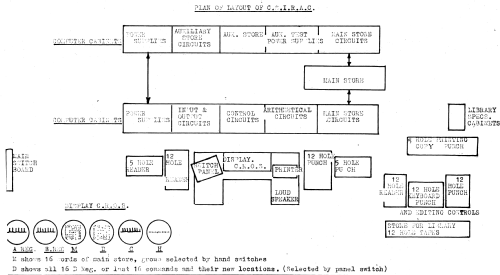CSIRAC early Computer
CSIRO Division of Radiophysics, Epping, New South Wales
- Country
- Australia
- Manufacturer / Brand
- CSIRO Division of Radiophysics, Epping, New South Wales
- Year
- 1949
- Category
- Signal Processing and Computing
- Radiomuseum.org ID
- 224749
Click on the schematic thumbnail to request the schematic as a free document.
- Number of Tubes
- 2000
- Main principle
- Audio-Amplification; 2 AF stage(s)
- Wave bands
- - without
- Power type and voltage
- Alternating Current supply (AC)
- Loudspeaker
- Permanent Magnet Dynamic (PDyn) Loudspeaker (moving coil)
- Material
- Metal case
- from Radiomuseum.org
- Model: CSIRAC early Computer - CSIRO Division of Radiophysics
- Shape
- Rack
- Notes
-
The fourth computer in the world, CSIRAC (pronounced 'sigh-rack') was designed and built in Australia. It made its first successful test run in November 1949.
CSIRAC is derived from Commonwealth Scientific and Industrial Research Organisation Automatic Computer.CSIRAC was a serial computer with mercury acoustic delay-line memory
The speaker's main purpose was for debugging. It was connected to the machine as an I/O device and instructions would be placed in the main program to produce "clicks" from the speaker. The operator would then know if the program had reached that part of the code successfully. - The first computer to play music was CSIRAC.
Speed .001MHz
Word size 20 bit
RAM 768 words
Disk capacity 2048 words
Power consumption 30,000 watts
2000 tubes
In the eight years of operation (about 30,000 hours of 'uptime') at Melbourne University, over 700 computing projects were processed by CSIRAC. One project was Computation of the radiation patterns of the rhombic antennae used by the Army Signals Branch at Donnybrook.
The CSIRAC is now in the MV Melbourne Museum. CSIRAC is the only intact first-generation computer surviving anywhere in the world.
- Net weight (2.2 lb = 1 kg)
- 7000 kg / 15418 lb 8 oz (15418.502 lb)
- Mentioned in
- MuseumVictoria
- Author
- Model page created by Heribert Jung. See "Data change" for further contributors.
- Other Models
-
Here you find 2 models, 2 with images and 2 with schematics for wireless sets etc. In French: TSF for Télégraphie sans fil.
All listed radios etc. from CSIRO Division of Radiophysics, Epping, New South Wales









